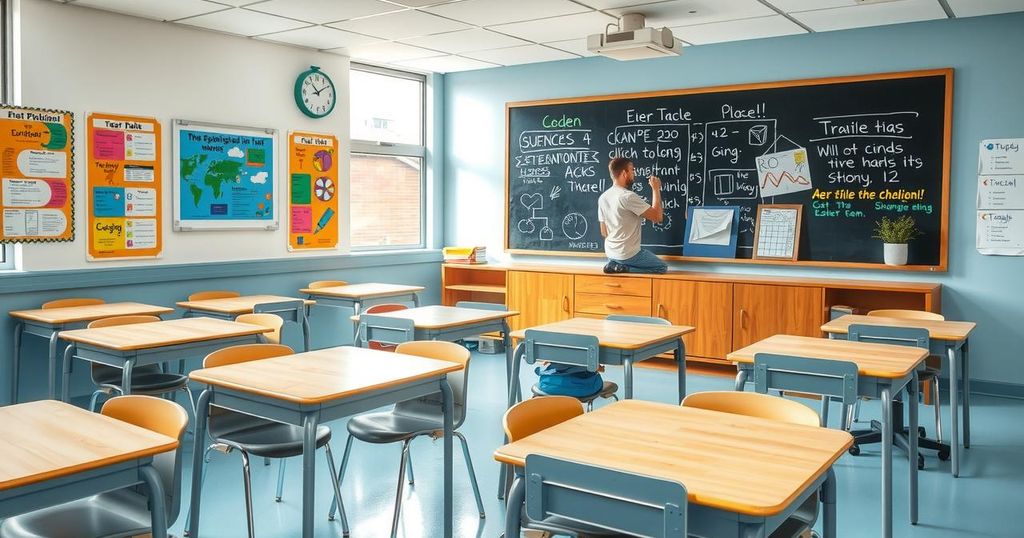Artificial Intelligence Isn’t Ruining Education; It’s Exposing What’s Broken
Artificial intelligence is not ruining education; it reveals existing flaws in the system. Students often leverage AI to complete assignments quickly instead of engaging in the learning process, highlighting a disconnection between educational policies and reality. Institutions need to reevaluate their approaches and integrate technology thoughtfully, ensuring it supports genuine educational efforts rather than undermining them.
Artificial intelligence (AI) isn’t destroying education; in fact, it’s shining a spotlight on some pretty significant issues. Recently, in my high school chemistry class, we went through an AI training session. They promised to teach us how to use ChatGPT responsibly, but in truth, most of us just used it to rush through the worksheets. When asked how AI could support our thinking, we skipped straight to using AI to finish homework instead.
Schools seem to have jumped the gun, trying to regulate AI based on this bright-eyed belief that students will embrace technology responsibly. The reality, though, is many of us simply want to complete assignments quicker. Current school policies—built on a foundation of hope and not reality—haven’t changed students’ habits. For example, ours instructs us to use ChatGPT only for brainstorming but zeroes out any work generated by AI itself. That distinction? It often becomes meaningless in practice.
I had a chat with my chemistry teacher afterward, who sadly admitted to reviewing Google Docs histories only to find students pasting in entire AI-generated paragraphs without any edits. This lack of genuine effort was disheartening. In Bible class, it got even more entertaining: one student read an entire ChatGPT output during a presentation, while another confidently discussed the “post-exilic” era—earlier having butched the word “patriarchy.” This left the teacher bemused, noting the secular terms used by ChatGPT while the whole class laughed it off.
To be honest, it’s apparent most of us aren’t embracing AI to enhance our education. Instead, we’re dodging the learning curve. What’s even more frustrating? Schools pretend like this isn’t happening. But I’m not a doomsayer about AI. There’s a way to incorporate these tools thoughtfully into lessons. However, giving students total access without checks is a misstep that undermines education’s purpose.
This issue isn’t limited to high schools. Take CSU, for instance, where administrators upheld a blind faith in responsible AI usage among students, despite studies indicating 72% of high schoolers use AI to finish tasks without real understanding. Tiffany Noel, an education researcher at SUNY Buffalo, aptly noted that AI didn’t damage deep learning; rather, it unearthed that many assignments never encouraged critical thinking in the first place—just a focus on performance. AI merely acts faster; the real problem lies in the existing framework.
The education system seems to prioritize grades over genuine comprehension, so when an easier path presents itself, many of us are inclined to follow it. This shortcuts real work, placing students who actually invest time into the assignments at a disadvantage. They put in an hour of effort only to see another classmate zoom through with AI assistance, yet both earn equal grades. Quite absurd, if you ask me.
Historically, students have sought to minimize workloads—copying homework, trading answers, and all that. But this situation is unique because it’s tied to a tool designed for educational aid. Schools are left exposed, and honest efforts by students can go unrecognized.
So, what’s the way forward here? First off, we need to acknowledge the truth: if something’s assigned for home, it’s likely going to involve AI. Plus, if students have internet access in class, well, you can bet they’ll exploit it. Let’s face it, teachers can’t monitor every screen all the time, and they shouldn’t have to either.
Setting stricter guidelines and clearer barriers is essential. AI should’t replace a student’s genuine academic work, just as calculators aren’t allowed in multiplication drills. Schools are meant for learning skills, not outsourcing them. AI might churn out answers, but homework should challenge students to think critically.
If an assignment can be completed in five seconds by AI, then it probably misses the mark completely. This doesn’t mean AI can’t find its way into classrooms—it just needs a better fit: behind desks, not in front of them. Let this tech assist teachers with grading or provide practice support. AI should be a supplementary tutor that challenges students rather than doing the heavy lifting for them.
It’s essential to frame education policies around how students really act rather than idealized versions of learners. Until we take this reality check, AI will continue to craft our essays, and educators will remain stuck grading shortcuts.
In essence, rather than ushering in doom for learning, AI is revealing educational flaws that have long existed. Schools must recognize this reality, accepting that students will utilize available tools, including AI, to navigate their assignments. It’s about striking a balance where AI serves as an aid rather than a crutch, reshaping both policy and practice to refocus on genuine learning and understanding.
Original Source: edsource.org




Post Comment